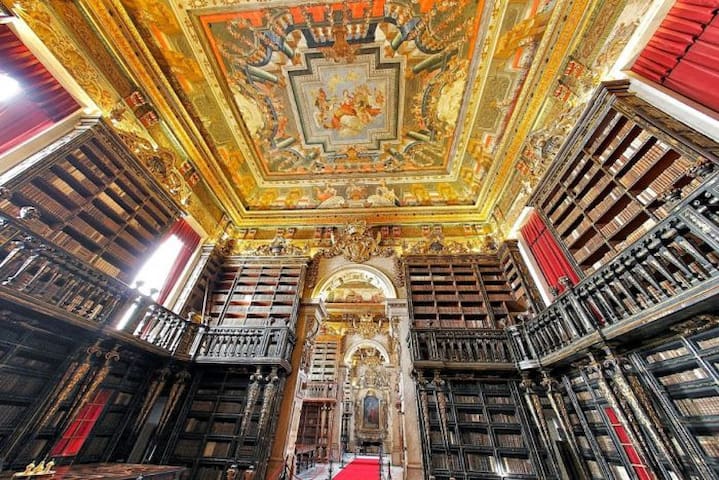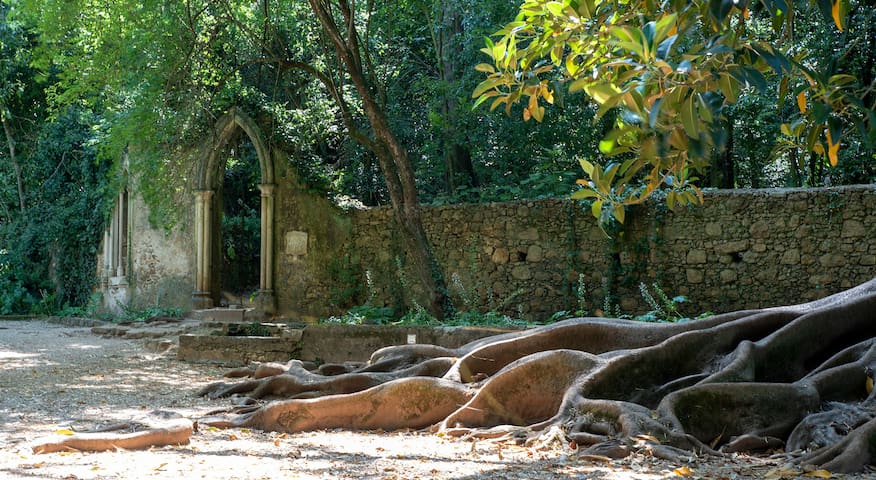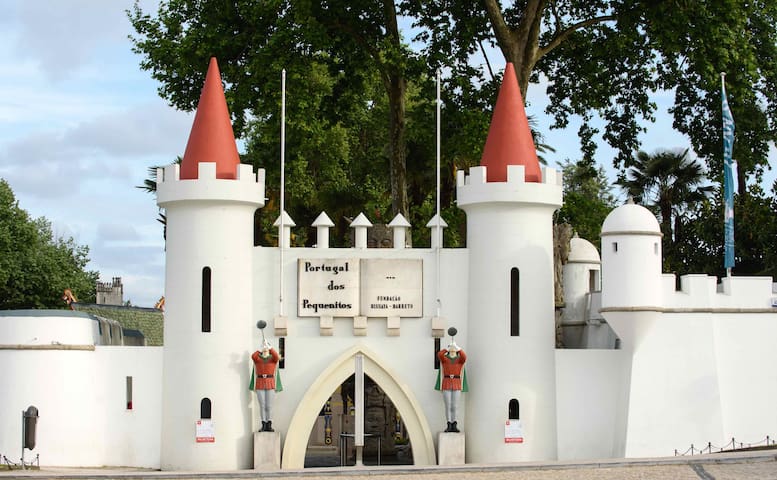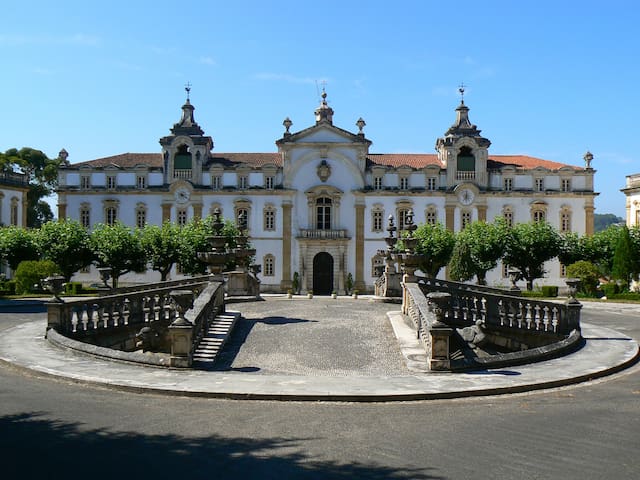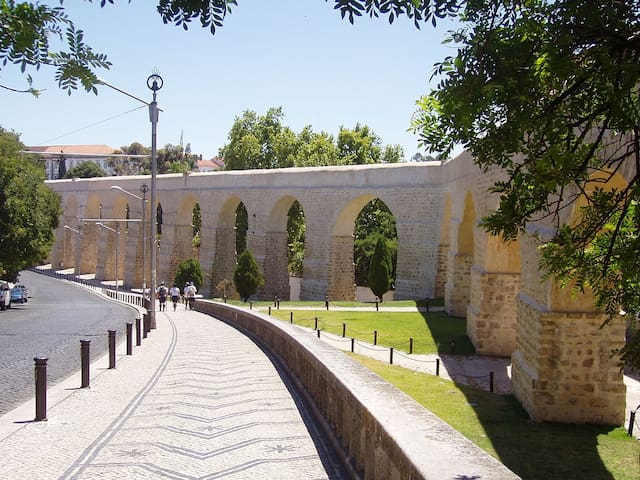The best places to visit in Coimbra
The University of Coimbra was founded in 1290 and is one of the oldest in Europe, and was classified World heritage site by UNESCO.
120 vietiniai rekomenduoja
University of Coimbra
The University of Coimbra was founded in 1290 and is one of the oldest in Europe, and was classified World heritage site by UNESCO.
Count Raczinski wrote about this library in "Les Arts au Portugal" in the following terms: «it is the most beautiful, most richly decorated library that I have ever seen». In fact, the beautiful and noble interior of this sumptuous space, built between 1717 and 1728, clearly expresses the generous spirit of its founding patron. Visitors are welcomed by the king's coat of arms above the great portico at the entrance.
Here, students and researchers may consult more than 300 thousand volumes dating from the 16th to the late 18th century, kept in the archives that cover three floors of the building.
51 vietiniai rekomenduoja
Biblioteca Joanina
Count Raczinski wrote about this library in "Les Arts au Portugal" in the following terms: «it is the most beautiful, most richly decorated library that I have ever seen». In fact, the beautiful and noble interior of this sumptuous space, built between 1717 and 1728, clearly expresses the generous spirit of its founding patron. Visitors are welcomed by the king's coat of arms above the great portico at the entrance.
Here, students and researchers may consult more than 300 thousand volumes dating from the 16th to the late 18th century, kept in the archives that cover three floors of the building.
The name is a homage by the city of Coimbra, his birthplace, to Joaquim Machado de Castro, the most notable representative of 18th century Portuguese sculpture. The bishop's palace, which houses the collections, retains the fine 12th-century cloister, creating the ideal environment for one of the most complete art collections in Portugal.
Below the museum, visit one of the most impressive buildings from the Roman era still preserved in Portugal: a huge, monumental series of galleries, on two storeys, which are thought to have been designed to support an enormous square or a forum in the ancient city of Aeminium (Coimbra).
67 vietiniai rekomenduoja
Machado de Castro Nacionalinis muziejus
Largo Doutor José RodriguesThe name is a homage by the city of Coimbra, his birthplace, to Joaquim Machado de Castro, the most notable representative of 18th century Portuguese sculpture. The bishop's palace, which houses the collections, retains the fine 12th-century cloister, creating the ideal environment for one of the most complete art collections in Portugal.
Below the museum, visit one of the most impressive buildings from the Roman era still preserved in Portugal: a huge, monumental series of galleries, on two storeys, which are thought to have been designed to support an enormous square or a forum in the ancient city of Aeminium (Coimbra).
Founded in 1283, by Dame Mor Dias, a gentlewoman of Coimbra, the Monastery of Santa Clara was initially a modest ensemble, consisting of a small church, cloister and dormitory. However, the original works were embargoed by the Canons of Saint Augustine, who did not see the foundation of a new monastic house with good eyes and demanded the extinction of the Order of Saint Clare.
Years later, in 1314, Isabel of Aragon, the Holy Queen, was interested in the re-founding of the monastery, having built new buildings of which stand out the cloister and the church, sacred in 1330.
35 vietiniai rekomenduoja
Museu do Mosteiro de Santa Clara a Velha
57 R. BaixoFounded in 1283, by Dame Mor Dias, a gentlewoman of Coimbra, the Monastery of Santa Clara was initially a modest ensemble, consisting of a small church, cloister and dormitory. However, the original works were embargoed by the Canons of Saint Augustine, who did not see the foundation of a new monastic house with good eyes and demanded the extinction of the Order of Saint Clare.
Years later, in 1314, Isabel of Aragon, the Holy Queen, was interested in the re-founding of the monastery, having built new buildings of which stand out the cloister and the church, sacred in 1330.
Quinta das Lágrimas: the story of a forbidden love.
A love story becomes great because of the tales that keep it alive. And the story of Peter and Inês is no exception.
Although the Prince lived with Inês at Santa Clara Palace for many years, folk tradition says that, in order to communicate with his lover, Peter would use a pipe which went through Quinta das Lágrimas until near the Poor Clairs convent. It is said that he would put letters into small wooden boats and then they would travel across the water that came from a fountain, the Fonte dos Amores (Fountain of Love).
At Quinta das Lágrimas there is also another fountain, the Fonte das Lágrimas (Fountain of Tears) which, according to legend, is made out of the tears that Inês cried when she was murdered. It is said that the blood from her body left a stain of red seaweed which is still noticeable today.
21 vietiniai rekomenduoja
Quinta das Lágrimas sodai
1 R. José Vilarinho RaposoQuinta das Lágrimas: the story of a forbidden love.
A love story becomes great because of the tales that keep it alive. And the story of Peter and Inês is no exception.
Although the Prince lived with Inês at Santa Clara Palace for many years, folk tradition says that, in order to communicate with his lover, Peter would use a pipe which went through Quinta das Lágrimas until near the Poor Clairs convent. It is said that he would put letters into small wooden boats and then they would travel across the water that came from a fountain, the Fonte dos Amores (Fountain of Love).
At Quinta das Lágrimas there is also another fountain, the Fonte das Lágrimas (Fountain of Tears) which, according to legend, is made out of the tears that Inês cried when she was murdered. It is said that the blood from her body left a stain of red seaweed which is still noticeable today.
It is the oldest Portuguese theme park, consisting of six major themes: Regional houses (Representation of the traditional houses of the different regions of Portugal); Monumental Portugal (where the most significant monuments of Portugal are reproduced); City of Coimbra (special highlight for the city and its history); Insular Portugal (with reproduction of monuments from Madeira and the Azores) and portuguese speaking countries, ancient colonial territories (where the old traditional houses and ethnographic elements of the ancient colonial territories are represented). It was a complement to the educational project, which established a network of kindergartens and whose goal was that children could learn by playing in the park, outside the school building, in interaction with “the reality”. It is a place where space and time are compressed to dimensions that can be apprehended by all, especially by the children and that produces a certain notion of enchantment.
61 vietiniai rekomenduoja
Portugalijos mažyliai
Largo Rossio de Santa ClaraIt is the oldest Portuguese theme park, consisting of six major themes: Regional houses (Representation of the traditional houses of the different regions of Portugal); Monumental Portugal (where the most significant monuments of Portugal are reproduced); City of Coimbra (special highlight for the city and its history); Insular Portugal (with reproduction of monuments from Madeira and the Azores) and portuguese speaking countries, ancient colonial territories (where the old traditional houses and ethnographic elements of the ancient colonial territories are represented). It was a complement to the educational project, which established a network of kindergartens and whose goal was that children could learn by playing in the park, outside the school building, in interaction with “the reality”. It is a place where space and time are compressed to dimensions that can be apprehended by all, especially by the children and that produces a certain notion of enchantment.
The Church of the Holy Family, with its dome, is considered one of the most beautiful in the country; the chapel-reliquary of Saint Michael; the old library, with more than nine thousand books from the years 1507 to 1800; the episcopal lodging; the tiled room; and the Mondego balcony, with a magnificent view over the city. Also noteworthy are a woodcut by Monsignor Nunes Pereira, a canvas of the famous painter Grão Vasco and the tube organ of the 18th century, built in 1762 by João Fontana de Maquera, which is inserted in the category of “Iberian organs” and has 1500 tubes.
Major Seminary of Coimbra
2 R. VandelliThe Church of the Holy Family, with its dome, is considered one of the most beautiful in the country; the chapel-reliquary of Saint Michael; the old library, with more than nine thousand books from the years 1507 to 1800; the episcopal lodging; the tiled room; and the Mondego balcony, with a magnificent view over the city. Also noteworthy are a woodcut by Monsignor Nunes Pereira, a canvas of the famous painter Grão Vasco and the tube organ of the 18th century, built in 1762 by João Fontana de Maquera, which is inserted in the category of “Iberian organs” and has 1500 tubes.
Spread over various levels, staircases and avenues, the Botanic Garden is one of the most renowned botanical gardens in the world, allowing a trip to the four corners of the earth, due to its plant diversity. The woods occupy two-thirds of the total garden area, which is essentially composed of exotic trees in free growth and bamboo woods.
99 vietiniai rekomenduoja
Koimbros universiteto botanikos sodas
Calçada Martim de FreitasSpread over various levels, staircases and avenues, the Botanic Garden is one of the most renowned botanical gardens in the world, allowing a trip to the four corners of the earth, due to its plant diversity. The woods occupy two-thirds of the total garden area, which is essentially composed of exotic trees in free growth and bamboo woods.
Popularly known as Arcos do Jardim [Garden Arches] given its contiguous location to the botanical garden of the University of Coimbra, this aqueduct construction was ordered by King D. Sebastião in 1570, to supply water to the city’s Alta area [uptown], taking advantage of the existing route of the Roman aqueduct that existed before.
6 vietiniai rekomenduoja
Arcos do Jardim
1887 Alameda Júlio HenriquesPopularly known as Arcos do Jardim [Garden Arches] given its contiguous location to the botanical garden of the University of Coimbra, this aqueduct construction was ordered by King D. Sebastião in 1570, to supply water to the city’s Alta area [uptown], taking advantage of the existing route of the Roman aqueduct that existed before.


